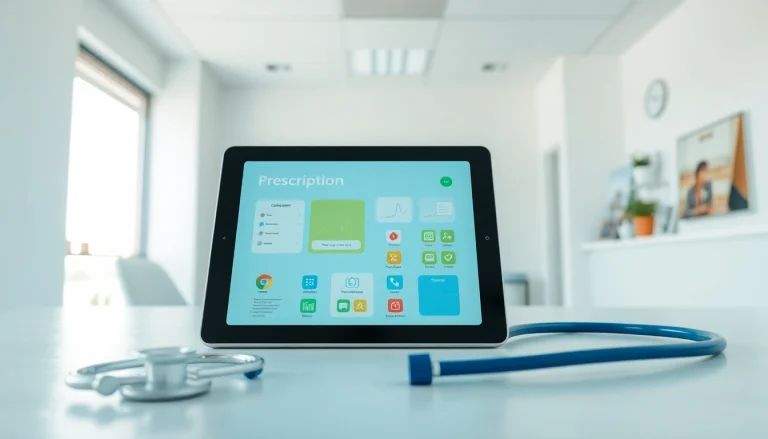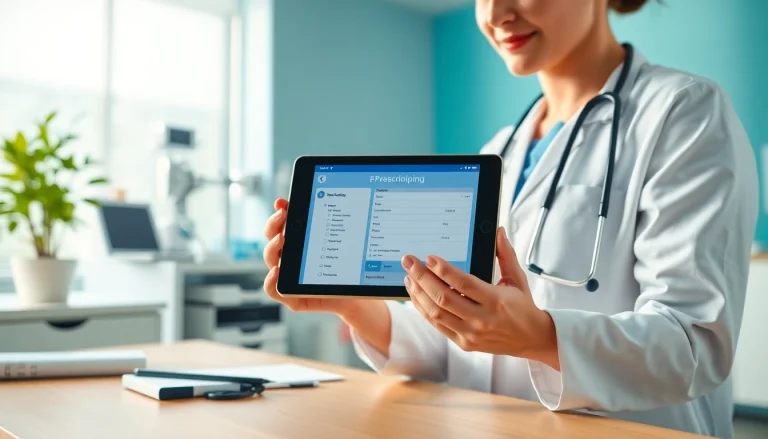
Understanding ePrescribing Software and Its Benefits
What is ePrescribing Software?
E-prescribing software is a digital tool utilized by healthcare providers to create, send, and manage prescriptions electronically. This technology allows for streamlined communication between practitioners and pharmacies, eliminating the need for handwritten prescriptions and reducing the chances of errors. With e-prescribing, healthcare providers can electronically transmit a patient’s prescription details to a pharmacy of choice, where it can be filled promptly, enhancing efficiency in the medication management process.
Core Benefits of ePrescribing
Adopting e-prescribing software carries significant benefits for healthcare providers, patients, and pharmacies alike:
- Increased Prescription Accuracy: E-prescribing reduces errors stemming from illegible handwriting and misinterpretation, which can occur with traditional paper prescriptions.
- Improved Workflow: With electronic systems, providers can streamline their workflow, spending less time on paperwork and more time on patient care.
- Real-Time Information Access: Providers have immediate access to a patient’s medication history and allergies, empowering them to make informed prescribing decisions.
- Enhanced Patient Safety: E-prescribing alerts help avoid potential drug interactions and allergies, significantly increasing patient safety.
- Convenience for Patients: Patients benefit from the ability to send prescriptions electronically to the pharmacy, minimizing wait times and enhancing overall care experience.
Challenges in Adoption and Use
Despite the numerous advantages, there are challenges in the adoption and usage of e-prescribing software:
- Cost of Implementation: Initial costs for purchasing and implementing e-prescribing systems can be a barrier for some healthcare practices.
- Resistance to Change: Some healthcare providers may be apprehensive about transitioning from traditional methods, fearing it might disrupt their current practices.
- Technical Difficulties: Issues such as system downtime or compatibility problems with existing healthcare infrastructure can hinder seamless e-prescribing.
Critical Features to Look for in ePrescribing Software
User-Friendly Interface
An intuitive user interface is essential for the effective use of e-prescribing software. Providers should look for systems that are easy to navigate, reducing the learning curve and allowing for more efficient prescription management. Interfaces that minimize the number of clicks required to complete a task can significantly enhance user experience.
Integration with EHR Systems
The software should seamlessly integrate with existing Electronic Health Record (EHR) systems, enabling a unified workflow. This integration ensures that patient data is synced across platforms, allowing providers to access comprehensive patient information in real-time and aiding in better decision-making.
Compliance and Security Measures
Given the sensitivity of patient data, e-prescribing software must adhere to encryption standards and regulatory compliance, such as HIPAA. Providers should ensure that the software includes robust security features and compliance protocols to protect patient information from breaches and misuse.
Evaluating ePrescribing Software Reviews and Ratings
Understanding Metrics for Evaluation
When considering e-prescribing software, it is paramount to evaluate software reviews based on reliable metrics. Factors such as user satisfaction ratings, ease of integration, and customer support must be assessed. Average ratings can be useful, but it’s the feedback from users covering various aspects of the software that provides deeper insights into its capabilities and limitations.
Common User Experiences
Analyzing common user experiences can reveal a lot about the strengths and weaknesses of e-prescribing solutions. Users often comment on the speed of the software, the clarity of prescription submissions, and the efficiency of workflow integration. Critiques may include issues with system glitches or customer service responsiveness, which can influence the overall user experience.
Insights from Industry Experts
Consultation with industry experts can provide valuable insights into the best practices for selecting e-prescribing software. Experts often highlight the importance of running pilot programs during the selection process and recommend gathering input from staff who will use the software regularly to ensure that it suits the team’s needs and workflow.
Cost Analysis of Top ePrescribing Solutions
Upfront Costs vs. Long-term Savings
Understanding the financial implications of implementing e-prescribing software encompasses both upfront costs and potential long-term savings. Initial investments may include software purchase, training expenses, and potential disruptions during transition periods. However, the long-term savings realized via improved efficiency, reduced error rates, and enhanced patient care can significantly outweigh these costs.
Subscription Models and Pricing Variations
Many e-prescribing solutions operate on various subscription models that can impact overall costs. These models may be monthly or annual rates based on the number of users or transactions. It is crucial to analyze these models thoroughly and select a plan that aligns with the practice’s specific needs and budget constraints.
Value for Money in ePrescribing Software
Evaluating the value for money requires a holistic view of not just the pricing but the overall benefits provided by the software. Features such as customer support, updates, and additional tools like analytics and reporting capabilities should be compared against costs. A cheaper solution may provoke hidden costs or lack essential features, making a more expensive option ultimately the better investment.
Future Trends in ePrescribing Software
Innovations Driving the Future
The landscape of e-prescribing is continually evolving with technological advancements. Future innovations may include the use of artificial intelligence to enhance decision-making processes, predictive analytics for understanding patient medication adherence, and further improvements in interoperability between different health systems. Staying abreast of these innovations can significantly benefit healthcare practices.
Regulatory Changes Impacting ePrescribing
As the healthcare industry evolves, so do the regulations surrounding e-prescribing. Keeping up-to-date with changes in laws, such as prescription drug monitoring programs (PDMP) and updates in secure electronic transmission protocols, is vital for compliance. Practices must be proactive in adapting their systems to meet these evolving legislative requirements.
Preparing for Emerging Technologies
Practices that wish to stay ahead in the field of e-prescribing should prepare for the integration of emerging technologies. This includes telemedicine platforms, mobile applications for patient engagement, and blockchain for maintaining an immutable record of prescriptions. Adopting a forward-thinking approach can enhance patient care and operational efficiency.






